29 June 2022 – The University of Cambridge Institute for Sustainability Leadership’s (CISL) ClimateWise has published a new white paper on secondary perils.
Download the report
This report seeks to understand how the insurance industry can refine the way it defines, measures, and underwrites secondary perils amidst an evolving climate risk landscape. The report, written in collaboration with Deloitte, outlines key issues the insurance sector faces regarding secondary perils and the surrounding discourse, and identifies the main challenges that inhibit the industry from taking requisite action. The report concludes with high-level, practical recommendations to empower the full insurance value chain, with the goal of increasing financial, social and climate resilience and raising awareness of the urgent need for change.
Inconsistency in the definition and use of the term secondary perils is a key problem observed throughout the research and report. The report finds there are three key characteristics of a peril that influence whether it tends to be categorised as either ‘primary’ or ‘secondary’.Secondary perils are usually considered to fall into at least one of the following categories:
-
Perils with a lower frequency/severity and impact than others; and/or
-
Perils that take place as a result of another event; and/or
-
Perils that are less well and less widely modelled.
Other significant issues identified by the paper include the lack of quality and consistency in secondary peril data, differential treatment of secondary perils across the insurance value chain, and changes in physical landscapes due to climate change and non-climate shifts, which are contributing to the rapidly changing nature of secondary perils. This changing nature of secondary peril risk threatens societal, financial and physical resilience worldwide.
Urgent action is needed by the insurance industry to address these issues, however there are a number of barriers to the requisite action. Firstly, modelling limitations and the historical prioritisation of resources towards more significant ‘primary’ perils has taken attention away from ‘secondary’ perils such as flood and wildfire. The lack of available, consistent and high-quality data inhibits risk understanding and management. In addition to this, these issues sit against a complex backdrop of commercial, competitive and market considerations that hindering cross-value-chain action, information sharing and accurate pricing.
The report concludes with six high-level recommendations for industry participants:
-
Standardise the definition and use of the term ‘secondary perils’
-
Bold secondary peril leadership - focused on education and communication
-
Rethink value-chain engagement and collaboration on secondary perils
-
Diversify modelling approaches and challenge assumptions around secondary perils
-
Accelerate the deployment of capital to address and innovate around secondary perils
-
Encourage dynamic underwriting practices to enhance secondary peril exposure management capabilities, and incentivise resilience measures among policyholders
Commenting on the release of the new paper, Dr Bronwyn Claire, ClimateWise Lead at CISL, said:
“As the climate changes, the frequency and severity of risks the insurance industry manages will change. Particularly for secondary perils, this means we must be on the front foot in advancing industry modelling skills and client understanding of exposure to physical risks.”
Neal Baumann, Global Insurance Lead at Deloitte, said:
“The insurance industry sits at the forefront of climate risk and the race to both mitigate and build resilience against our changing climate. The topic of secondary perils is widely talked about but not yet well enough understood. Is the level of inconsistency in terminology and measurement of secondary perils still tolerable for the industry in today’s risk landscape? We believe not. Addressing the challenges raised in this paper will promote greater resilience in a number of ways: the financial resilience of the insurance industry, the physical climate resilience of communities and infrastructure, and the wider resilience of societies. Driving this agenda forward is an essential part of making sure the insurance industry fulfils its role in the climate transition, and a challenge on which Deloitte is delighted to have joined forces with ClimateWise to explore. This paper provides a timely call to action for all participants in the insurance value chain, and we look forward to the action it will prompt.”
Citing this report
University of Cambridge Institute for Sustainability Leadership (CISL). (2022). Modelling it all: Secondary Perils in a warming world. Cambridge, UK: University of Cambridge Institute for Sustainability Leadership.




